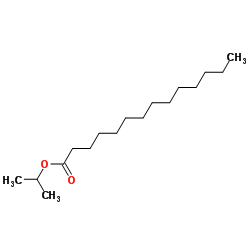Isopropyl myristate

Isopropyl myristate structure
|
Common Name | Isopropyl myristate | ||
|---|---|---|---|---|
| CAS Number | 110-27-0 | Molecular Weight | 270.451 | |
| Density | 0.9±0.1 g/cm3 | Boiling Point | 319.9±0.0 °C at 760 mmHg | |
| Molecular Formula | C17H34O2 | Melting Point | -5°C | |
| MSDS | Chinese USA | Flash Point | 144.1±8.8 °C | |
|
Development of novel formulations to enhance in vivo transdermal permeation of tocopherol.
Acta. Pharm. 64(3) , 299-309, (2014) Tocopherol represents a big challenge for transdermal permeation owing to its extreme hydrophobicity and large molecular mass. The aim of the present study was to develop alpha-tocopherol (T) topical formulations and evaluate their ex vivo and in vivo permeat... |
|
|
Clonal diversity of Acinetobacter baumannii from diabetic patients in Saudi Arabian hospitals.
J. Med. Microbiol. 63(Pt 11) , 1460-6, (2014) Carbapenem-resistant Acinetobacter baumannii (CR-AB) represents a major health-care problem, causing high rates of morbidity and mortality. This study investigated the clonality of CR-AB isolated from diabetic patients from different regions in Saudi Arabia, ... |
|
|
Non-animal photosafety screening for complex cosmetic ingredients with photochemical and photobiochemical assessment tools.
Regul Toxicol Pharmacol 72 , 578-85, (2015) Previously, a non-animal screening approach was proposed for evaluating photosafety of cosmetic ingredients by means of in vitro photochemical and photobiochemical assays; however, complex cosmetic ingredients, such as plant extracts and polymers, could not b... |
|
|
Esculentin-1a(1-21)NH2: a frog skin-derived peptide for microbial keratitis.
Cell. Mol. Life Sci. 72(3) , 617-27, (2015) Pseudomonas aeruginosa is the primary bacterial pathogen causing contact lens related keratitis. Available ophthalmic agents have reduced efficacy and antimicrobial peptides (AMPs) hold promise as future antibiotics. Here we investigated the in vitro and in v... |
|
|
Tumor-targeted responsive nanoparticle-based systems for magnetic resonance imaging and therapy.
Pharm. Res. 31(12) , 3487-502, (2014) Design and synthesis of a tumor responsive nanoparticle-based system for imaging and treatment of various cancers.Manganese oxide nanoparticles (Mn3O4 NPs) were synthesized and modified with LHRH targeting peptide or anti-melanoma antibodies (cancer targeting... |
|
|
In vitro evaluation of transdermal patches of flurbiprofen with ethyl cellulose.
Acta Pol. Pharm. 71(2) , 287-95, (2014) This study was aimed to determine effects of penetration enhancers and plasticizers on drug release from rationally designed formulations of flurbiprofen based transdermal drug delivery system. Matrix type transdermal patches were formulated with ethyl cellul... |
|
|
Importance of a suitable working protocol for tape stripping experiments on porcine ear skin: Influence of lipophilic formulations and strip adhesion impairment.
Int. J. Pharm. 491 , 162-9, (2015) The tape stripping method is a very important tool for dermopharmacokinetic experiments in vitro and the accurate measurement of the removed corneocytes is key for a reliable calculation of a drug's skin penetration behavior. Therefore, various methods to qua... |
|
|
Influence of lidocaine hydrochloride and penetration enhancers on the barrier function of human skin.
Int. J. Pharm. 477(1-2) , 416-20, (2014) Skin penetration enhancers (SPEs) are commonly employed in pharmaceutical and personal care products. These compounds transiently alter the barrier properties of the skin and we have previously investigated the effects of specific SPEs on skin barrier functio... |
|
|
Influence of a multiple emulsion, liposomes and a microemulsion gel on sebum, skin hydration and TEWL.
Int. J. Cosmet. Sci. 37(2) , 181-6, (2015) In this study, the influence of three cosmetically relevant, priorly characterized vehicles on skin hydration, sebum content and transepidermal water loss was investigated. The chosen vehicles included a liposomal pre-formulation, a multiple W/O/W emulsion an... |
|
|
Intranasal in situ gel loaded with saquinavir mesylate nanosized microemulsion: preparation, characterization, and in vivo evaluation.
Int. J. Pharm. 475(1-2) , 191-7, (2014) Saquinavir mesylate (SM) is a protease inhibitor with activity against human immunodeficiency virus type 1 (HIV-1) and is available in tablet form, which has three major problems. First, the drug undergoes extensive first pass metabolism. Second, the drug has... |